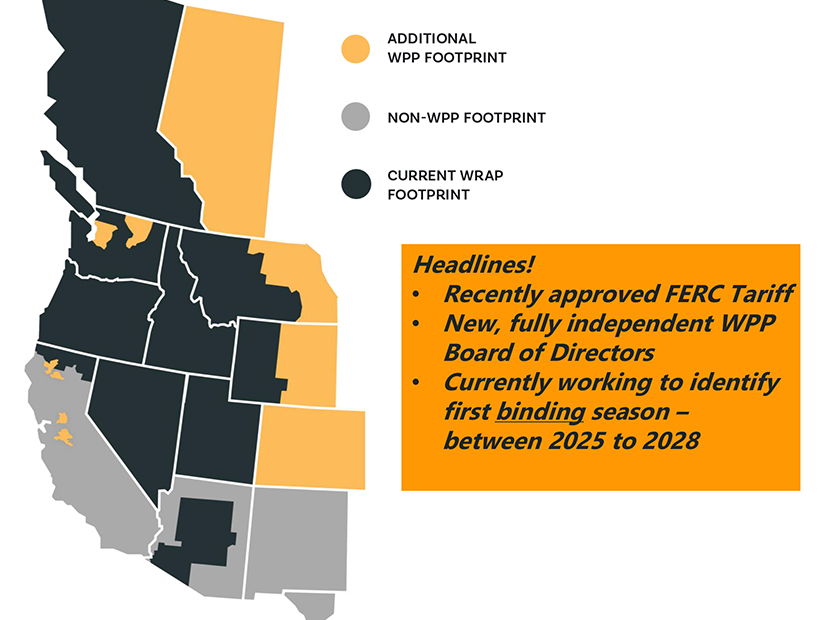
Western Power Pool CEO Sarah Edmonds would like to see the Western Resource Adequacy Program (WRAP) become “binding” on its participants as soon as possible, but making that transition could still be years away, she said last week.
After winning FERC approval for the WRAP tariff last month, WPP now has the option to initiate the binding phase of the program during any season between 2025 and 2028. At that point, participants will subject to “very, very significant” penalties for not meeting their resource adequacy obligations outlined under the program, Edmonds said in a briefing to WECC’s Board of Directors on Wednesday.
Edmonds emphasized that the WRAP is not the product of any state or federal requirements but was developed by electric industry participants as a voluntary program to address concerns about imminent RA shortfalls in the West.
“Once [load-serving entities] are in the program, they are obligated at least for a period of two years to fully comply with all the [RA] metrics, so to get these companies comfortable with jumping into this compliance framework, where there are significant consequences, we have to offer some flexibility about when the binding season will occur,” Edmonds said.
The current “nonbinding” phase continues to offer important lessons for participants, she pointed out.
“To be candid, some load-serving entities are in better shape to go binding than others. Others need a little more time to adjust their procurement strategies and their positions relative to what they see coming at them,” she said.
Edmonds said the WPP is in a “very active” discussion with the WRAP’s current 19 participants about when to enter the binding phase.
“I will certainly be pushing for the earliest possible binding season, but we also have that built-in flexibility, and that was the bargain that we struck to get this program off the ground,” she said.
‘Insurance Policy’
Edmonds outlined some of the challenges — and risks — participants face in entering the binding phase. She said the WRAP is “a little novel” compared with other RA programs in that it includes a strict deliverability requirement, which stipulates that a resource must have 75% firm or conditional firm transmission from source to sink to be considered compliant with the program’s counting rules.
Seven months ahead of a season, a participant must provide WPP a “workbook” of “forward showings” of their RA, which the program operator evaluates to ensure the participant is meeting its specific allocation of the WRAP planning reserve margin.
“When we say you’re a little bit short, and you have few months to cure, if you don’t cure, you are subject to pretty significant penalties,” Edmonds said. “They are of such significance that they’re really trying to send an economic signal that you should not lean on this program. You cannot rely on this program to serve your load; you need to solve your own problem.”
Once a season becomes the current operations period, the program operator will monitor conditions and notify participants of any expected RA deficits relative to their workbooks seven days in advance of an operations day.
“If they want to go out and fix that problem without relying on the program, we encourage it. The program is not meant to be the first go-to place for serving load; it is meant to be an insurance policy … a backstop,” Edmonds said.
From an operational standpoint, the WRAP “is really delivering surplus to deficit entities in those hours of highest need,” Edmonds said. “It relies entirely on using traditional bilateral trading mechanisms and transmission which is sold under open-access transmission tariffs. We’re not a market; we’re not creating anything there. We’re relying on what’s out there, but we are matching up the surplus and the deficits and creating the overall structure.”
Edmonds likened the WRAP to a contingency reserve program “in the sense that we are creating a pool with the right to call on the pool.”
“Those entities receive that insurance policy. They get help through that difficult day to serve their load,” subject to paying a settlement price for drawing on the pool, she said.
And while the WRAP has the potential to reduce its participants’ planning reserve margins over time through more coordinated resource sharing and a greater diversity of resources, getting there is part of the broader learning process of the nonbinding phase, Edmonds said.
“Is everyone in a position to yield that benefit right away? Probably not. I mentioned to you that there are some entities that are going to have to adjust into that position over a period of time. But overall, and in the long term, the goal of the forward showing is to get to that lower potential position,” Edmonds said.

